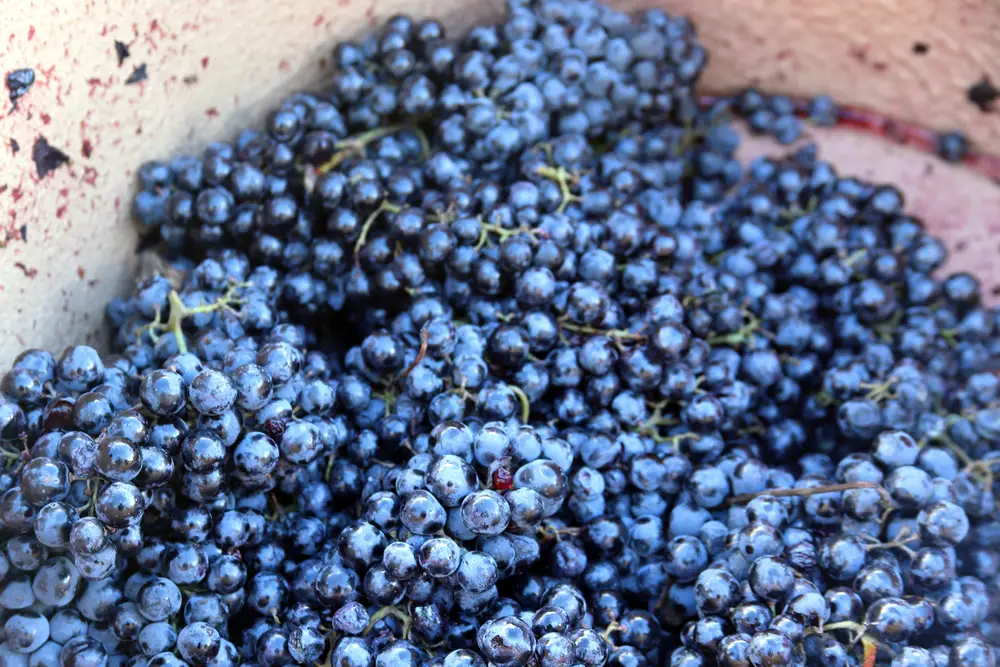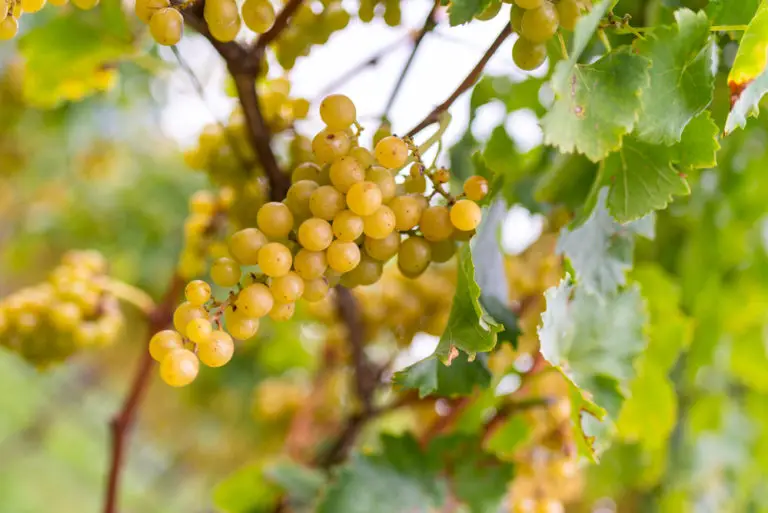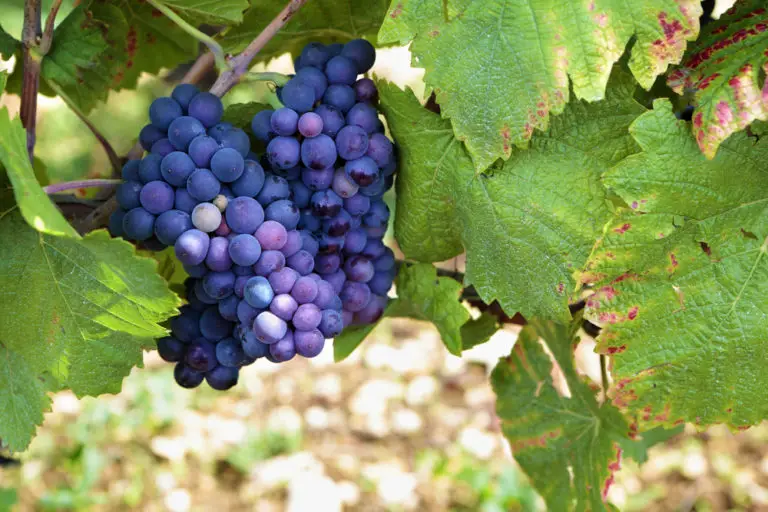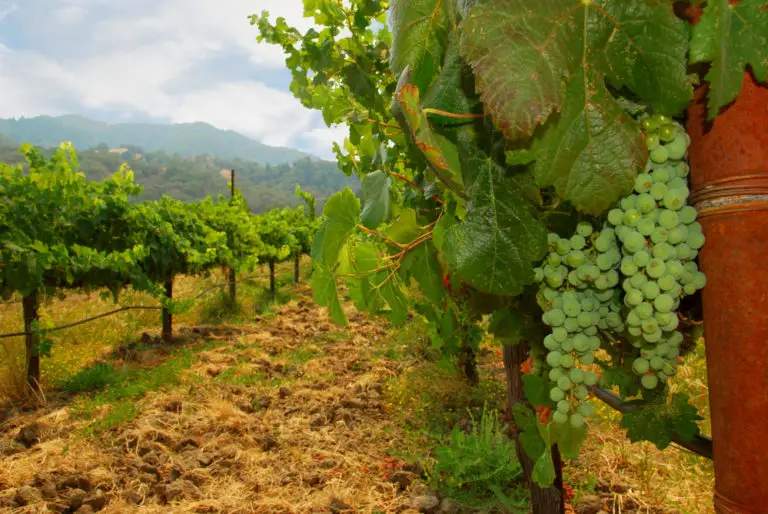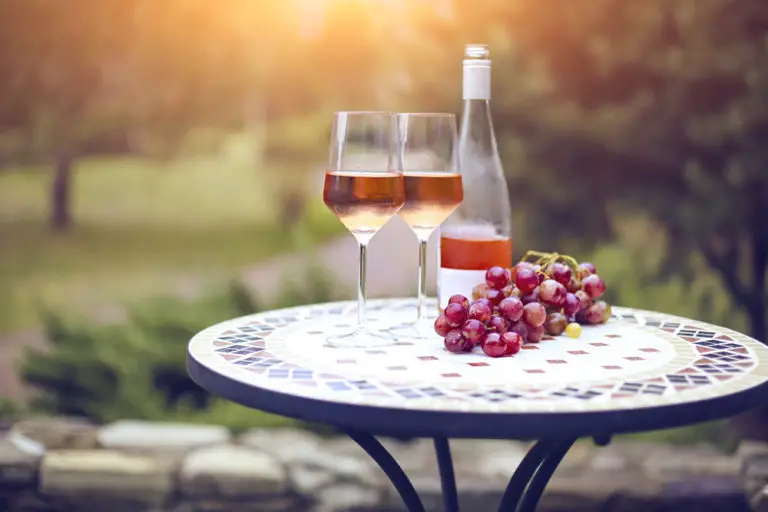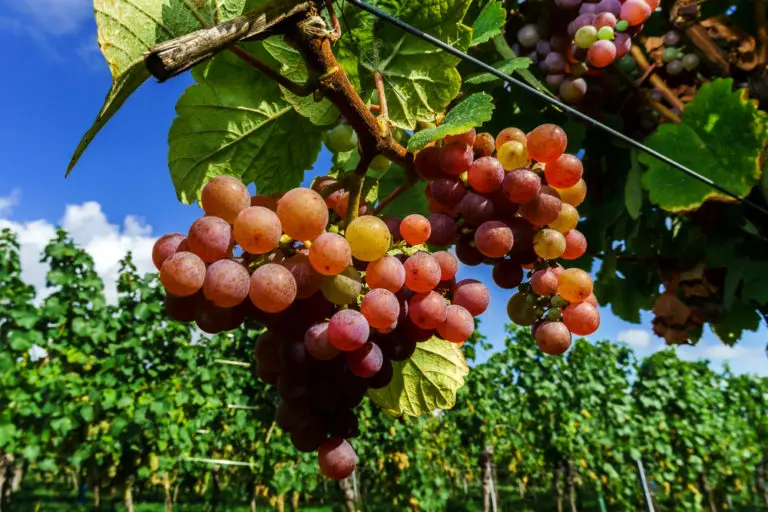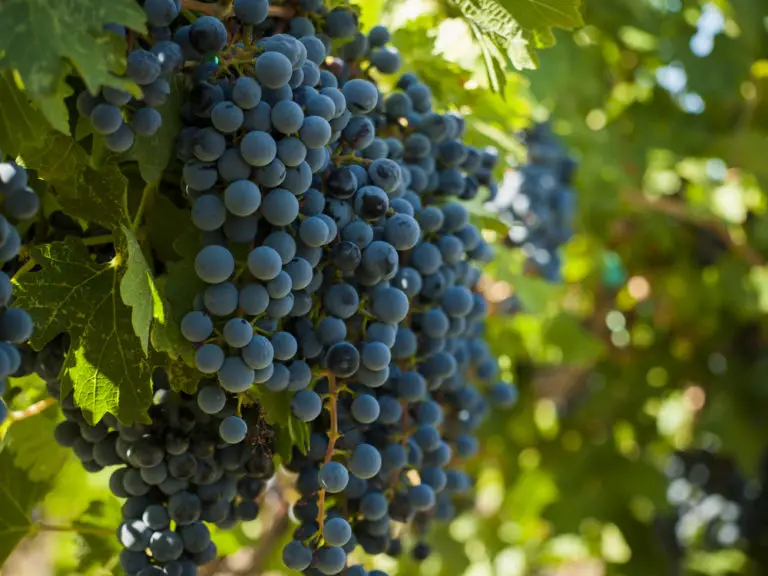Alicante Bouschet: The Beginners Guide (2024)
Alicante Bouschet is a red grape variety, that is, mainly grown in the south of France and North Africa. In Spain, this variety is called Garnacha Tintorera. There are currently more than 36,000 hectares Worldwide planted with Alicante Bouschet. Alicante Bouschet was bred to obtain the most colorful grapes possible, which should first give the wine visual depth.
- What is Alicante Bouschet?
- Known Regions for Alicante Bouschet
- Popular Blends of Alicante Bouschet
- How to Enjoy Alicante Bouschet?
- How is Alicante Bouschet Made?
- History of Alicante Bouschet
- Alternatives for Alicante Bouschet
What is Alicante Bouschet?
Alicante Bouschet is a deep, dark purple herald having a heavy and spicy aroma of red and black fruits. It presents itself powerfully and with a complex body. On the palate, it is well balanced, with a perfect acidity structure and a long-lasting chocolate finish. Alicante Bouschet pronunciation is ah-leh-cant Boo-Shay.
The meat of the Alicante Bouschet is red. It sprouts very early, which exposes it to the risk of spring frosts in cool regions. But it matures after a short to medium-long period. Large plantings can also be found in Castile-La Mancha in Spain as well as in Portugal. Italy has minor plantings in Tuscany or Sardinia.
There are a few hundred hectares each in Argentina, Chile, and California. Especially their good yields and their modesty and resilience made them particularly popular with French winemakers after the phylloxera disaster.
Alicante Bouschet vs. Carignan vs. Barbera
The Carignan vine is very old and got its name from the Spanish city of Cariñena. It is rich in tannins and acids, and the color is deep dark. Unfortunately, it lacks individuality and finesse; only old vines produce wine with character.
Therefore, Carignan is mainly used in combination with Cinsault and Grenache. The strength of Carignan lies in its high yields and its positive properties as a blended wine. Its weakness is disease susceptibility: powdery mildew and downy mildew, as well as rot, make it difficult for Carignan.
The Barbera grape is one of the most commonly grown red grape varieties in Italy. The smell of the wine is characterized by a stone fruit aroma. Its taste is valued because it has little tannin and invigorating acidity.
The variety is also suitable for aging in barrique barrels. These wines have high storage potential. Many different styles of wine are produced from this grape variety, ranging from still and dry to sparkling and sweet bottlings.
Alicante Bouschet Characteristics
The main Alicante Bouschet characteristic is undoubtedly the strong dark red color, whose skin tends to be dark blue and violet. The vine is known for the production of, particularly alcoholic wine. It is sometimes combined with grapes with a lower alcohol content to obtain even lighter and rosé wines.
Alicante is a product with strong consistency and structure. From a first analysis, it can be defined as a wine with very intense color, given by the very dark skin. Upon an olfactory analysis, it releases a rich and intense bouquet, in which it is possible to distinguish pleasant aromatic notes and tones of blackberry fruits, such as blackberries and blueberries, and intense sweet nuances of spices. When drunk, Alicante stands out for its full and soft taste, particularly rich in tannins.
Alicante Bouschet Taste Profile
This big, bold wine is undoubtedly fruitful. The Alicante Bouschet flavor profile can range from fresh to candied blackberries, blueberries, black cherries, and more. It has spicy, smoky flavors and sweeter shades of dark chocolate, baking spices, and vanilla seeds. It has floral notes with Mediterranean aromas. Round mouth, enveloping, elegant, and balanced with spicy touches and a long finish.
While Alicante Bouschet profile is higher in body, alcohol, and tannins, its structure varies depending on the climate. In colder regions, the acidity can be sharp. But, in warmer areas, it looks more like smooth, ready-to-drink black gold.
Alicante Bouschet Ageability
Alicante Bouschet grapes are meticulously classified in the winery. Fermentation takes place in open stainless steel tanks using only native yeasts. Later the wine is transferred to new French oak barrels, where malolactic fermentation occurs. Each plot is harvested, fermented, and aged separately for approximately 18 months. It is bottled unfiltered.
Known Regions for Alicante Bouschet
Many American and French producers in the mid-1900s realized that Alicante Bouschet flavour was not imperative. The growth declined when the winemakers understood that the grape’s rich color was no longer required. This variety loves dry, hot areas with a lot of sun. Here are some of the Alicante Bouschet regions that are widely growing Alicante Bouschet:
- Portugal: Alicante Bouschet varietal is considered one of southern Portugal’s most important red grapes amongst the many indigenous varieties that this country produces. It is mostly produced in the Alentejo region as it is dry and hot. It is often available as a single-varietal wine or blended with other varieties as well.
- Spain: In Spain, Garnacha Tintorera is the name by which Alicante Bouschet is famous. The Castilla-La Mancha is the most important area for Alicante Bouschet as it is warm and centrally located. You will find wines from here as both blend with Monastrell (aka Mourvèdre) and Tempranillo and singular varietal.
- France: This country is the homeland of Alicante Bouschet. It is mostly used for blends. You can find it in the regions of South West, Provence, Languedoc-Roussillon, and Corsica.
- Other Regions: Alicante Bouschet grape is grown in various other regions like Israel, Calabria, Tuscany, Chile, and Algeria. Approximately 1000 acres of this variety is grown in California, especially in the central valley regions of Madera and Lodi.
Popular Blends of Alicante Bouschet
Alicante Bouschet is used for making wines both as singular varietal and blends. A lot of Alicante Bouschet wines are quite famous. Let us take a look at these:
Esporao Reserva Red
This wine consists of 30% Alicante Bouschet abv along with 40% Aragonez (Tempranillo), 20% Trincadeira and 10% Cabernet Sauvignon. All these varieties are from Alentejo, Portugal, and the wine is aged for 12 months 40% French oak barrels and 60% American. This wine has residual sugar of just 2.5 g/L.
Capela Santa Margarida
This wine is a blend of 40% Trincadeira, 40% Aragonez (Tempranillo) and the rest is Alicante Bouschet alcohol percentage. All these grapes are from Montemor-o-Novo in Alentejo, Portugal, and are grown organically. The wine is kept in stainless steel for nine months and the bottle for three months before releasing in the market.
Montaria
This Alicante Bouschet blend consists of 30% Aragonez and 30% Trincadeira from Portugal. It has a 13% of abv and a warm, soft structured mouthfeel. The aromas are mostly of red fruits with hints of tobacco. Montaria has good acidity and a high drinkability factor. It ends up dry with a long finish of spice, juicy dark fruit, and a bit of tobacco.
Esparao 4 Quatro Castas
This blend of 4 wines- 25% Petit Verdot, 25% Alicante Bouschet alcohol content, 25% Syrah and 25% Petit Verdot. This wine is from Alentejo, Portugal, and the aroma of this wine is predominantly oaks, dark fruit, and mint. It leaves an oak, dark chocolate, black cherry, and coffee flavor at the end.
How to Enjoy Alicante Bouschet?
Bouschet wine, similar to any other wine, has certain suggestions that would enhance its tastes. This red wine is best served with smoked meat, grilled vegetables, or teriyaki. It should be served at a temperature between 16º and 18ºC. Let us look into the details and learn more about this wine.
Food Pairings
Since Alicante Bouschet is a heavy wine, it pairs perfectly with intense foods like BBQ or smoked meat and grilled vegetables. You can also pair it with roasted lamb or pig, teriyaki, or carne asada. Here are some Alicante Bouschet wine pairing:
- BBQ and Smoked Meat: The high fat and umami in the meat balance the tannins of Alicante wine. You can season it with tangy, smoky, spice, or sweet flavors and matching sauces.
- Grilled Vegetables: Grilled vegetables are best paired with an acidic and light wine. Therefore, they pair well together. Grilled vegetables can also be served with other wines like Rueda, Verdicchio, and Arneis.
- Roasted Lamb or Pig: Lamb and pig are the most wine-friendly meats out there. They can pair with both Old and New World wines. The way they are cooked does make a huge impact on their pairing with the wines. A heavily spices Lamb or Pig will be the best option to try with Alicante Bouschet.
- Carne Asada: If you want to try Mexican food along with a glass of alicante bouschet, then you can try carne asada. This delicious marinated steak dish is perfect for this red wine and creates a perfect balance with each other.
Temperature
Serving red wines at room temperature is an old rule of thumb, but it is old and dates back to times when the apartments were rather cool even in summer. Powerful heavy wines taste best at 18, at most 19°C, while temperatures between 16 and 18°C are suitable for most other red wines. Lighter wines also tolerate lower temperatures between 14 and 16°C.
If that is too complicated for you, you can use the following rule of thumb as a guide: Enjoy expensive red wines at 18°C, all others at 16°C , at most 18°C.
Therefore, the ideal temperature to drink Alicante Bouschet is between 16º and 18ºC.
Stemware
Glass, in addition to its aesthetic aspect, is necessary for more than one way. First of all, it allows the wine to reveal its finery. The aromas are expressed more freely in large, extended glasses than in small, narrow glasses. The size of the glass and its opening are determining factors for the wine.
- Authentic 02 De Spiegelau: Manufactured in the German factories of Spiegelau, the crystal is very shiny and particularly elastic to impact. A little heavy when handling, this glass is nevertheless ideal for professionals and individuals. Its size is an asset for red wines such as those from the northern Rhône valley. Here, the fruit is highlighted and not the alcohol. Therefore, it is ideal for drinking Alicante Bouschet.
- Vinum De Riedel: This Austrian family business is a benchmark in the world of wine tasting. It was one of the first to offer a range of glasses, each responding to the aromatic diversity of the grape varieties. When tasting, it turns out to be a good compromise for sparkling wines by allowing a rapid opening of the aromatic palette and transmitting a beautiful finesse of bubbles.
- Universal De Zalto: Originally from Italy, the Zalto brand is now installed in Austria. The lightness and slender appearance of Universal glass are impressive. This thinness translates to great fragility. It makes excellent glass for deciphering wines with a strong mineral identity.
How is Alicante Bouschet Made?
There are many ways and procedures to make red wine. But in all cases, to make red wine, the following procedure is followed. The same is followed for Alicante Bouschet winemaking:
1. Destemming
The grapes are harvested from Alicante Bouschet vineyard and are sent to the winery immediately. Here, stalk, as well as any vegetable part, is removed from the alicante grape through a process called “destemming” that can be manual, mechanical, or both. In the elaboration of high-quality red wine, the elimination of vegetal remains is fundamental since their presence produces a myriad of defects in the final result.
2. Squeezed
Once de-stemmed, a machine squeezes the grapes, and a liquid paste is obtained to which sulfur dioxide is added. Subsequently, the paste is transferred to a tank, where fermentation begins, a process in which the temperature should never exceed 30º.
3. Fermentation
During this process, gas is released that pushes up the grape skins (skins), where a layer called ‘hat’ is formed. Optionally from this moment on, two procedures can be carried out to improve the quality of the wine: Pumping over, which consists of stirring using pumps; and Bazuqueo, which consists of stirring using a stick.
4. Pressing
After fermentation and, if it has been carried out, after bleeding, the wine is transferred to the press where, thanks to strong mechanical pressures, the wine is obtained. The remains of the pressing, called ‘pomace’ are sent to the alcoholic beverages for distillation. Different ways of pressing wine produce different qualities of wine.
5. Racking
The wine is transferred from one tank to another in a process called ‘racking’. In this, the wine becomes clean due to the accumulation of solid materials in its bottom. This rinsing process is favored by the cold and low outdoor temperatures characteristic of winter. Racking is repeated periodically, thus avoiding possible contamination caused by solid remains still present in the wine.
6. Storage and Bottling
Once the above processes have been completed, the wines are selected by quality, and their destination is decided: immediate release to the market or greater or lesser storage in a process called ‘aging’ or ‘aging’.
History of Alicante Bouschet
The grape was first grown in France in 1866 by Henri Bouschet (who had created it in 1855) as a cross between Petit Bouschet and Garnacha. Petit Bouschet was a grape created by his father, Louis Bouschet.
The result was to produce a grape with an intense Alicante Bouschet wine color and a higher quality than the teinturier du Cher. Some varieties of Alicante Bouschet history were produced of varying quality. The grape with higher yields and easier maintenance gained popularity among French winemakers, especially in the years following the phylloxera epidemic.
At the end of the 19th century, there were plantations of Garnacha tintorera in Bordeaux, Burgundy, the Loire Valley, and in Alentejo (Portugal).
The grape was widely known in the United States during the Prohibition years. Californian farmers in the Central Valley discovered that its pulp was so fleshy and juicy that its juice could be fermented up to the third press.
In contrast, wines made from grapes like chardonnay and merlot typically only include the juice from the first or second pressing. In 1928, an auctioned lot of 225 wagons of this grape was acquired by a single buyer.
Alternatives for Alicante Bouschet
If you are a lover of rich, fruit-forward reds like Alicante Bouschet and are bored drinking the same wine for some time. You can try these three wines: Zinfandel, Shiraz, and Cabernet Sauvignon. Their similar structure makes them a perfect alternative for the Alicante Bouschet alcohol.
Zinfandel
Zinfandel is a thin-skinned variety that does not make as dark wine as Alicante Bouschet color but has a similar taste spectrum. Zinfandel has white flesh whereas Alicante Bouschet has red flesh. Therefore, though they both have a fruity taste, they have some differences.
Shiraz
Shiraz is one of the finest red wine grapes in the world and produces great wines from good winemakers. Depending on the region, the grape produces juicy and fruity to spicy and complex and highly concentrated wines. With low yields and full physiological maturity in very good locations, results in deep red, tannin-rich wines with a scent of violets and Reseda.
Cabernet Sauvignon
Cabernet Sauvignon vines produce deeply dark, bluish grapes with small, thick-skinned berries.
While ripe Cabernet Sauvignon smells seductively of dark berries (especially blackcurrants) if it is insufficiently ripe, less friendly aromas such as green peppers, black pepper, and bitterness that is reminiscent of dry stems dominate.
Regardless of where and under what conditions the wines are vinified from it, the variety always shows its character: a lot of structure and tannin with precise currant aromas.
FAQ
What does Alicante Bouschet taste like?
Alicante Bouschet taste is unquestionably fruit-forward, with flavors ranging from blueberries, black cherries, jammy blackberries, and more. It has spicy, smoky flavors, with tones of baking spice, vanilla bean, and dark chocolate.
Is Alicante Bouschet a rose wine?
According to Alicante Bouschet descriptors, Alicante has red skin and flesh that provides the wine a beautiful red color. Alicante, therefore, is a red wine and not rose wine.
Should Alicante Bouschet be refrigerated?
Alicante Bouschet should be served around from 57 to 62 degrees Fahrenheit. The lower end of this allows the wine to warm slightly in the glass as it is enjoyed.
How do you drink Alicante Bouschet?
Alicante Bouchet should be ideally drunk at a temperature between 57 to 62 degrees Fahrenheit. It can be paired with intense foods like BBQ or smoked meat and grilled vegetables.
Is Alicante Bouschet dry or sweet wine?
Alicante Bouschet is a teinturier grape variety widely planted in Portugal, France and Spain, particularly in the Languedoc-Roussillon region. It is a dry wine.
What does Alicante Bouschet pair with?
It can be paired with intense foods like BBQ or smoked meat and grilled vegetables. You can also pair it with roasted lamb or pig, teriyaki, or carne asada.

